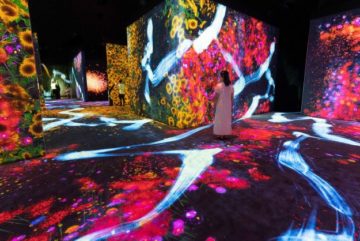
Originally published in the Marina Times San Francisco in October 2021
After Hope: Videos of Resistance and teamLab: Continuity at The Asian Art Museum
Through the end of the year, the Asian Art Museum will present video and interactive exhibits designed to drive us to imagine and create different worlds.
A Continuous Experience
After Hope: Videos of Resistance poses the question, “How does hope drive us to imagine new worlds?” An eclectic blend of 50 short films explores the role of hope in contemporary art and activism. On a loop 24 hours a day, the six-hour collection of films also includes participation from artists not typically represented in museums outside Asia; artists from Azerbaijan, Bangladesh, Malaysia, Mongolia, Pakistan, Palestine, Taiwan, Thailand and Turkey touch on a variety of contemporary topics. Fragments of issues and causes combine to reveal common themes relating to the environment, eco-feminism, queer ecologies, art and activism, transgressive histories, speculative futures, song, music, and stories of exile, diaspora and identity in this repeated circle of imagery.
“After Hope ropes in all these fragmented issues and causes and reveals common themes – refuge, renewal, revolution – almost like a chain letter or an exquisite corpse,” explains Abby Chen, head of contemporary art at the Asian Art Museum, referring to the Surrealist game whereby artists contribute a sketch or a word to an continual composition, and the work is only revealed in its entirety at the end of the process. “It’s a surprisingly emotional experience and people who spend even a little bit of time with these videos, whether in our gallery, or online at home, will come away with a broader, richer, more timely connection to Asia.” Visitors “drop in” to their own unique experience of the continuum, creating their own connections between the videos they happen upon as they consider their own ideas about the meaning of “hope.”
After Hope: Videos of Resistance is one of a three-part interrelated program produced in collaboration with outside curators and institutions aiming to foster artistic pollination across communities, practices, and perspectives. The additional offerings include a series of convenings in the International Working Group, and a digital platform, AfterHope.com. Video art, as an accessible and immediate art form, has the power to create a sense of global solidarity. Jay Xu, CEO of the Asian Art Museum says “…masterpieces that illuminate our essential humanity—as well as the profound shifts of our own century – are still being made today, and in the digital age, great art is as likely to appear on our phones as it is in a magnificent gallery setting.”
Tokyo-Based International Art Collective Creates Immersive Experience
teamLab: Continuity consists of fourteen movement-sensitive artworks, filling the gallery space in a hyper-response to human activity, and transforming visitors into participants. The digital animation’s reactive algorithm responds to the locations and movements of the museumgoers as they move through space, creating a kind of artistic fingerprint of that particular moment.
Creating digital art experiences around the world, several hundred programmers and designers comprise the teamLab collective, traditionally working together behind the scenes creating art and exploring the relationship between the individual and the world.
Sketch Aquarium and Sketch Ocean
At the new Shriram Experiential Learning Center, a school of glowing sea creatures swim through an aquarium brought to life from the creativity of the public. What started in February 2020 as teamLab: Sketch Aquarium is now teamLab: Sketch Ocean with the opening of the Continuity exhibition. This is the place to go if you have always wanted to see your artwork come to life, float and swirl across museum walls. A “submersive” experience, the designs swim off the page to join an ocean teeming with fish, a collective creation. Visitors are welcome to drop in, grab a template and create their sea creature. When it’s completed, a museum volunteer scans the paper and adds the newest creation to the ever-changing artwork.
“Continuity prompts us to consider our own impact on the environment and relationship to technology as a force for social evolution,” says exhibition organizer Dr. Karin G. Oen, Principal Research Fellow at the Centre for Asian Art and Design in the School of Art, Design and Media, Nanyang Technological University, Singapore and former associate curator of contemporary art at the Asian Art Museum. “It’s a subtle yet potent reminder that the art and experiences we most enjoy can also be revolutionary.”